| Mouth and Muzzle |
|
1901 Standard
|
1935 standard
|
| Mouth. Quite level, but of the two a slightly
overshot
mouth is preferable to an undershot one. The teeth are somewhat smaller
than would be expected in a Terrier of the size. In this respect, the breed
seems to suffer to an extraordinary degree from cankered teeth. I have
never yet seen an imported specimen with a sound mouth.
Fore face of fair length, strong in front of the eyes, the nose, large,
prominent and pointed, not depressed; a square muzzle is objectionable. |
Mouth and Muzzle - Mouth level, otherwise slightly
undershot preferable. Muzzle of medium length; a square muzzle is objectionable. |
The Lhasa muzzle is a compromise between shortening to conserve heat
and the requirement for a nasal chamber of adequate length to warm and
humidify the inspired air. At one third of the total head length, it falls
midway between the normal 1:1 head of the wolf type, and the extremely
foreshortened heads of some ornamental breeds. The bite is the one which
most often goes with this slightly modified head. The original standard
adopted in both Britain and the USA in 1934 stated that the "mouth is
level, otherwise slightly undershot preferred". The statement "mouth
level" means that the upper and lower jaws are equal in length. The tooth
occlusion in this situation will be either level, level-scissor or reverse
scissor. (The "level-scissor" is a bite where the jaws are level, but the
upper teeth overlap the lower. It is not a true scissor bite as
in the German Shepherd, which is a true scissor mouth.) A level
mouthed dog will have a typical "blunt" muzzle regardless of the dental
occlusion... (In fact a "level mouth" would be a level mouth even with
no teeth at all.) A secondary choice would be slightly undershot.
For quite a number of years the AKC in its official "Complete Dog Book"
defined level mouth as "the normal canine mouth" (ie scissor
bite). In 1978, the American standard changed the word "mouth" to the word
"bite", thereby drastically altering the meaning. A level "mouth" refers
to the jaws being level, which means the teeth can be level, scissor, or
reverse scissor, whereas level "bite" means only one thing: a "pincer"
bite. This change of one word has brought about the present confusion regarding
level and scissor bites. The misguided change in the words "mouth" to "bite"
caused a level-scissor bite, which was perfectly acceptable as a "level
mouth" in 1977, to be unacceptable in 1978.
The English Standard has been altered twice since 1934. The English
have recently opted for a more "Oriental" type face with an undershot,
turned up muzzle, seemingly without regard to the fact that the Lhasa is
not an "oriental", but a central Asian breed. The latest English change
in the standard, while accepted by FCI, was rejected by their cousins in
Australia. The new English standard of bite, which described the teeth
as being in a straight line between the canines, was one of the major objections
by the Australians. (Teeth in a straight line is a characteristic of the
Bulldog, the Pekinese and several similar breeds, but not of the Lhasa
Apso.).
The adoption of these changes apparently ignored the fact that the majority
of the original dogs which came from the Himalaya as gifts from the Dalai
Lama or collected by the Baileys and Cuttings had level mouths. They did
not have the turned up, undershot mouths desired under the present English
and FCI Standards. Photos and descriptions of the breed from the thirties
and forties show this quite clearly. The much earlier description of the
breed, printed in 1901, stated " Mouth quite level, but of the two
a slightly overshot mouth is preferable to an undershot one." Most
of the recent specimens brought from the Himalayas have had scissor bites.
While in Europe, breeders and judges have adopted, as correct, a turned
up, undershot jaw, against which a mountain existence would certainly select,
because of the airway compromises involved. These jaw and dental abnormalities,
some of which are actively sought by misguided western breeders and judges,
are real disadvantages for a Tibetan dog.
Aside from strong historical arguments for rejection of the significantly
undershot mouth in favor of the level mouth, there are even stronger biologic
arguments. The undershot mouth, in which there is no occlusion between
upper and lower incisors, is a unhealthy mouth, leading to early loss of
teeth. All too often we see little rice-like teeth which have short roots
and are lost early. Teeth are kept healthy, as any dentist will tell you,
by contact and pressure from the teeth in the opposite jaw. Without this
pressure, the teeth are extruded, and bone is lost from around the unopposed
teeth, causing them to be loosened and lost early in life. In the grossly
undershot bite, the canines are misoccluded, whereas in a level or reverse
scissor bite, the lower canines fit into the space between the lateral
incisor and canine of the upper jaw. This relationship is important
in "anchoring" the bite in a stable occlusion. If the lower incisors lie
in a straight line between the canines, there is malocclusion of the canines,
with loss of stability of the anterior bite. Because the undershot
bite, in which the upper and lower incisors do not touch, and the canines
do not mesh properly, is unhealthy (just as unhealthy as a "parrot
mouth"), and a biologic disadvantage, it is not a suitable bite for
a Tibetan dog.
You, then, have to decide whether you think the present day revised
English and FCI versions of a Lhasa or the original Tibetan Lhasa represents
the true breed.
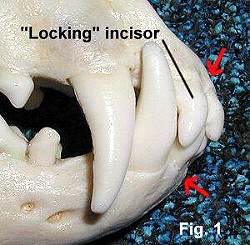
Figures 1 and 2 are photos of a normal canine skull.
Note the unequal length of the upper and lower jaws (red arrows).
Also note the way the upper lateral incisor "locks" around the lower
canine. Also note the absence of space between the anterior teeth
- they all mesh very tightly.
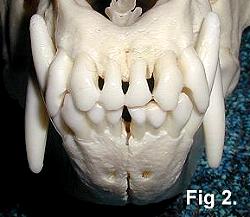
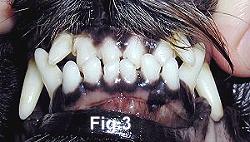
Figures 3 and 4 are photos of a 6 year old male Lhasa Apso with
a "reverse scissor" bite. Note how the upper lateral incisors
are displaced anteriorly by the lower canines and have been pushed out
of line with the other upper incisors. The lower canines -
in fact, the entire anterior segment of the lower jaw has moved forward
so that now the two jaws are equal in length.
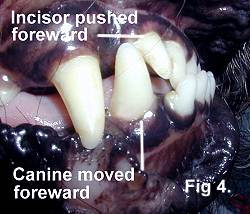
This slightly undershot bite is clearly not a normal canine bite,
but is still a relatively healthy bite because some semblance of
normal occlusion is preserved. A bite in which the lower canine is
located anterior to the upper lateral incisor is an unhealthy bite because
there is no anterior occlusion.
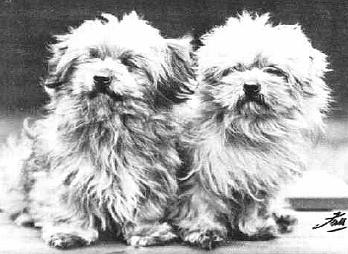
There is a preoccupation with the "undershot look" here and in Europe.
Proponents of this look claim that the Apso is an "Oriental" breed
and therefore should share a "puggy" heavy underjaw or chin
with other "Oriental" breeds. Not only is the Apso a Central Asian,
rather than "Oriental" breed, but examination of the earliest photos we
have of imports from Tibet reveal them to be quite the opposite of "puggy"
faced, but instead bear a very strong resemblance to Cairn Terriers!
Here is a photo of two of the Bailey dogs from the 30's (imports or first
generation). Note the distinct "terrier" quality of the heads and
the absence of a puggy "chin".




